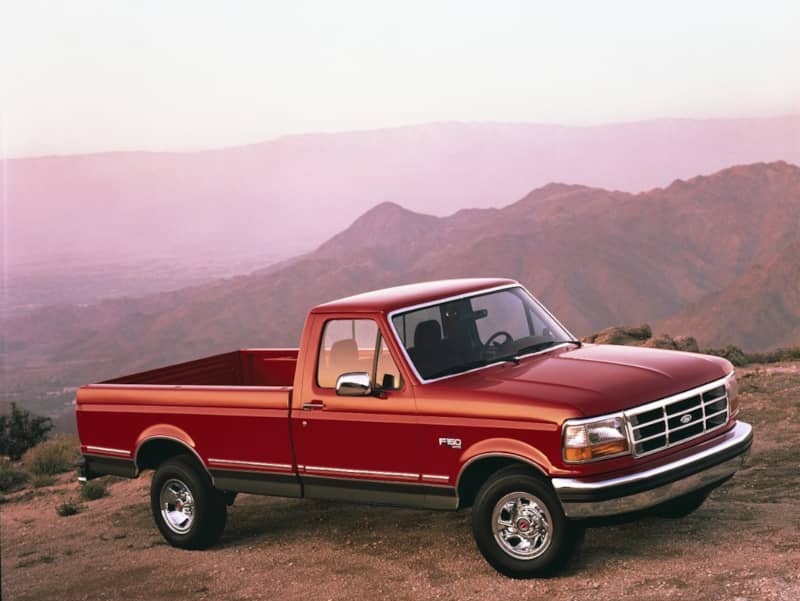Ford Winter Service Checklist: Cold Weather Maintenance
As the temperature drops and snowflakes begin to fall, it’s crucial to ensure your Ford vehicle is ready for the challenges of winter driving. This guide will walk you through essential maintenance steps to keep your Ford running smoothly and safely throughout the cold season. From tire care to battery checks, we’ll cover everything you … Continued
As the temperature drops and snowflakes begin to fall, it’s crucial to ensure your Ford vehicle is ready for the challenges of winter driving. This guide will walk you through essential maintenance steps to keep your Ford running smoothly and safely throughout the cold season. From tire care to battery checks, we’ll cover everything you need to know to winterize your Ford.

Tire Maintenance: Your First Line of Defense
Switch to Winter Tires
One of the most critical steps in preparing your Ford for winter is switching to winter tires. These specialized tires provide superior traction in snow, ice, and cold temperatures.
- Tread Design: Winter tires have deeper treads and unique patterns that channel snow and slush away from the tire’s surface.
- Rubber Compound: They’re made with a softer rubber compound that remains flexible in cold temperatures, ensuring better grip.
- Performance: Winter tires can improve braking distance by up to 25% compared to all-season tires in snowy conditions.
Check Tire Pressure Regularly
Cold weather causes tire pressure to drop. For every 5.6°C decrease in temperature, tire pressure decreases by about 6.9 kPa.
- Proper Inflation: Check your tire pressure at least once a month and before long trips.
- Recommended Pressure: Refer to your Ford manual or the sticker inside the driver’s side door jamb for the correct tire pressure.
- Benefits: Properly inflated tires improve fuel efficiency, handling, and life.
Rotate Your Tires
Regular tire rotation ensures even wear, especially during winter when traction is crucial.
- Rotation Schedule: Rotate your tires every 8,000 to 13,000 kilometers or as your Ford manual recommends.
- Rotation Pattern: Follow the appropriate rotation pattern for your Ford drivetrain (FWD, RWD, or AWD).
Battery Care: Ensure Reliable Starts
Cold weather can be tough on your Ford battery. A weak battery in warm weather may fail when temperatures plummet.
Battery Inspection
- Visual Check: Look for signs of corrosion on the terminals and cables.
- Clean Connections: If you see corrosion, clean it with a wire brush and a mixture of baking soda and water.
- Secure Mounting: Ensure the battery is securely mounted to prevent vibration damage.
Battery Testing
- Voltage Test: A fully charged battery should measure 12.6 volts when the engine is off.
- Load Test: This test checks the battery’s ability to hold a charge under load.
- Professional Check: Many Ford dealerships offer free battery testing services.
Consider Replacement
- Age Matters: If your battery is more than three years old, consider replacing it before winter.
- Cold Cranking Amps (CCA): Ensure any replacement battery meets or exceeds your Ford CCA requirements.
Fluid Checks and Changes
Proper fluid maintenance is crucial for your Ford winter performance.
Engine Oil
- Viscosity: Consider switching to a lower viscosity oil for winter (e.g., 5W-30 instead of 10W-30).
- Oil Change: If you’re due for an oil change, do it before winter sets in.
Antifreeze/Coolant
- 50/50 Mix: Ensure your coolant is a 50/50 mix of antifreeze and water for optimal freeze protection.
- Flush and Fill: If it’s been more than two years, consider a coolant flush and fill.
Windshield Washer Fluid
- Winter Formula: Use a winter-specific washer fluid that won’t freeze in low temperatures.
- Full Reservoir: Keep the reservoir full, as you’ll likely use more in winter conditions.
Brake Fluid
- Level Check: Ensure the brake fluid reservoir is full.
- Quality Check: If the fluid is dark or cloudy, it may be time for a brake fluid flush.
Visibility Enhancements
Clear visibility is paramount for safe winter driving in your Ford.
Wiper Blades
- Winter Blades: Consider switching to winter wiper blades, which prevent ice and snow buildup.
- Replacement: If your current blades are more than six months old or showing signs of wear, replace them.
Headlights and Taillights
- Clarity Check: Ensure all lights are working and the lenses are clear.
- Restoration: If headlight lenses are foggy, use a headlight restoration kit to improve visibility.
Defrosting System
- Test Run: Before winter hits, test your Ford defrosting and defogging systems to ensure they’re working properly.
- A/C Check: Remember, your air conditioning system helps dehumidify the air, aiding in defrosting.
Undercarriage and Exterior Protection
Protecting your Ford body from winter’s harsh elements is crucial for long-term durability.
Undercoating
- Rust Prevention: Consider applying an undercoating to protect against road salt and moisture.
- Professional Application: For best results, have this done by a certified Ford technician.
Waxing
- Paint Protection: A good coat of wax before winter can help protect your Ford paint from salt and grime.
- Frequency: Wax your vehicle every three months for optimal protection.
Door Seals
- Lubrication: Apply a silicone-based lubricant to door seals to prevent freezing and sticking.
Emergency Kit Preparation
Be prepared for winter emergencies by keeping a well-stocked kit in your Ford.
Essential Items:
- Jumper cables
- Flashlight with extra batteries
- First-aid kit
- Blanket or sleeping bag
- Snacks and water
- Ice scraper and snow brush
- Small shovel
- Bag of sand or kitty litter (for traction)
- Extra warm clothing and boots
- Phone charger
HVAC System Check
Ensure your Ford heating system is in top shape for winter comfort and safety.
Heater Check
- Performance Test: Run the heater on full blast to check for proper function.
- Odd Smells: If you notice any unusual odours, have the system checked for mold or mildew.
Cabin Air Filter
- Replacement: If it’s been more than a year or 24,000 kilometers, replace the cabin air filter.
- Benefits: A clean filter improves air quality and helps the HVAC system work more efficiently.
Fuel System Care
Keep your Ford fuel system in good condition for reliable winter performance.
Fuel Filter
- Inspection: Have your fuel filter checked and replaced if necessary.
- Frequency: TFuelfilters should be replaced every 32,000 to 64,000 kilometers.
Fuel Additives
- Gas Line Antifreeze: Consider using a gas line antifreeze product to prevent moisture in your fuel line from freezing.
- Fuel Stabilizer: If you plan to store your Ford for extended periods, use a fuel stabilizer to prevent fuel degradation.
Brake System Inspection
Reliable brakes are crucial for winter driving safety in your Ford.
Brake Pad Check
- Thickness: Have your brake pads inspected for thickness. Replace them if they’re less than 6.35 mm thick.
- Even Wear: Ensure pads are worn evenly on both sides.
Brake Fluid
- Level Check: Ensure the brake fluid reservoir is full.
- Quality Check: If the fluid is dark or cloudy, it may be time for a brake fluid flush.
Rotors and Calipers
- Visual Inspection: Look for signs of scoring on the rotors or sticking callipers
- Professional Check: If you notice any issues, have a certified Ford technician inspect your brake system.
Four-Wheel Drive and All-Wheel Drive Systems
If your Ford has 4WD or AWD:
System Check
- Engage the System: Before winter, engage the 4WD or AWD system to ensure it’s working properly.
- Fluid Check: Have the transfer case and differential fluids checked and changed if necessary.
Differential Service
- Inspection: Have the differentials inspected for leaks and proper fluid levels.
- Fluid Change: Follow your Ford recommended schedule for differential fluid changes.
Exhaust System Inspection
A properly functioning exhaust system is crucial for safety and efficiency.
Muffler and Pipes
- Visual Check: Inspect for any signs of rust, damage, or loose components.
- Leak Test: Have a professional check for exhaust leaks, which can be especially dangerous in winter when windows are often closed.
Catalytic Converter
- Performance Check: Ensure the catalytic converter is functioning properly to maintain fuel efficiency and reduce emissions.
Electrical System Review
Cold weather can strain your Ford electrical system.
Alternator Check
- Output Test: Have the alternator’s output tested to ensure it’s charging the battery properly.
- Belt Inspection: Check the alternator belt for cracks or wear.
Starter Motor
- Performance Test: Have the starter motor tested to ensure it can handle cold starts.
Suspension and Steering Inspection
A well-maintained suspension system is crucial for handling winter road conditions.
Shock Absorbers and Struts
- Visual Inspection: Check for signs of leaking or damage.
- Performance Test: Have a professional test the suspension components for proper function.
Power Steering
- Fluid Check: Ensure the power steering fluid is at the proper level.
- Hose Inspection: Check power steering hoses for cracks or leaks.
Ford-Specific Features
Many Ford vehicles come with special features designed for winter driving. Familiarize yourself with these:
Ford Co-Pilot360™ Technology
- Pre-Collision Assist: Ensure this system functions correctly to ensure added safety in slippery conditions.
- Lane-Keeping System: Verify that this feature is working properly to help maintain control on snow-covered roads.
Intelligent All-Wheel Drive
- System Check: For Ford models equipped with Intelligent AWD, check the system to ensure it’s ready to provide optimal traction in winter conditions.
Remote Start (if equipped)
- Functionality Test: Test your remote start feature to ensure it’s working correctly on those cold winter mornings.
Stay Safe On Winter Roads
By following this Ford Winter Service Checklist, you’ll ensure your vehicle is well-prepared to tackle the challenges of winter driving. Regular maintenance and proactive care improve safety and enhance your Ford performance and longevity. Remember, while many of these tasks can be DIY projects, don’t hesitate to consult with a certified Ford technician for more complex maintenance needs.
Stay safe on the winter roads, and enjoy the comfort and capability of your well-maintained Ford throughout the cold season. With proper preparation, your Ford will be ready to handle whatever winter throws its way, providing you with reliable transportation and peace of mind all season long.


